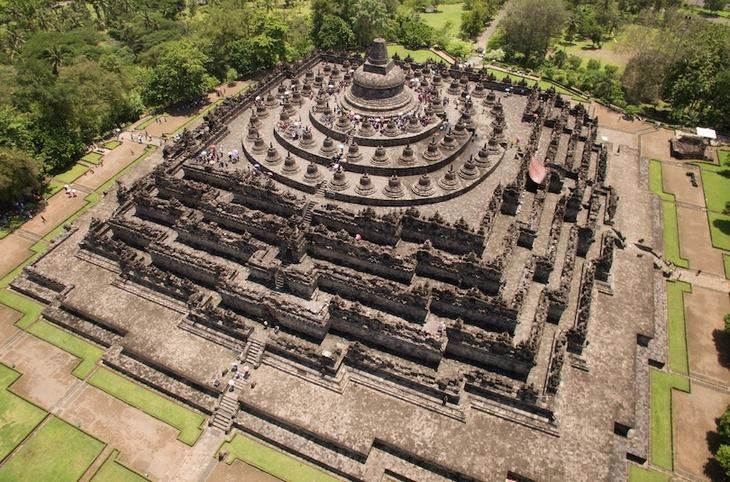The Borobudur in Indonesia, the largest Buddhist temple in the world.

Borobudur Temple, is the largest Buddhist monument in all of Southeast Asia and its origins date back to between 750 and 849.
This Buddhist structure, made with limestone, is an authentic wonder and heritage of humanity by Unesco.
Very well preserved and located about 75 km from Yogyakarta, this site is a must if we pass through Indonesia.
Location
Located in an enviable enclave, Borobudur is surrounded by rice fields, palm trees and abundant vegetation, under the watchful eye of the Merapi volcano.
Its measures per side are 118 meters x 118 meters and is 4 stories high until it reaches its highest part where the stupa is located, surrounded by bells (Buddhist symbol).
It is said that Borobudur is the idea that Buddhists of the cosmos had and through its construction they wanted to represent it.
Each floor is one of the states that Buddha went through before arriving in Nirvana (represented by the top).
Even today, it is not known for sure, how this Buddhist construction could reach the Island of Java, where there are no more buildings of this type.
The beauty and grandeur of Borobudur, went unnoticed for a long time, but luckily, its value has been returned to where it belongs.
The image of its dozens of perforated bells, is one of the most viewed in Indonesia and an authentic work of art.
¿How to get?
To get to Borobudur, from Yogyakarta, we have about 1 hour and little more, and excursions to visit it are sold throughout Indonesia.
The archaeological park of Borobudur
It is an oasis in the middle of Java, a Buddhist place in a Muslim environment, full of souvenir shops and prepared for tourists.
The Indonesian government has managed to give it an adequate approach, so that the Borobudur temple is in an environment according to its importance
10 curiosities about the Borobudur Temple
1-The name of Candi is given to Hindu or Buddhist temples in Indonesia, temples built especially in the period of compensation between the fourth and fifteenth centuries.
Candi Borobudur was declared a UNESCO World Heritage monument in 1991. And its construction may have begun in the year 800 after Christ.
2- The vast majority of the temples were built on flat surfaces, while Borobudur settled between two volcanoes and two rivers, was built on a rock hill 265 m above sea level and 15 m above the ground of an ancient lake already dry
3-It consists of 6 square platforms crowned by 3 circular platforms and is decorated with 504 Buddha statues and 2,672 relief panels.
4- Between the years 928 and 1006 After Christ, Borobudur was abandoned because political, cultural and religious power shifted eastward from Java.
5-It was not until 1814 when Borobudur began to attract visitors from all over the world thanks to Mr. Thomas Stamford Raffles, the Island of Java was still under English rule.
Borobudur’s first monumental monograph comes to light in 1873. But the biggest renovation was directed by UNESCO in 1973.

6-In 1900 during the restoration it was discovered that the 3 Buddhist temples in the region – Borobudur, Mendut and Pawon, are aligned in a straight line.
7-Huge amounts of stones, approximately 55,000 cubic meters, were used in the construction of Borobudur. The stones were transported through the nearby rivers.
8-The Borobudur Temple is equipped with an excellent drainage system to prevent flooding. They provide 100 nozzles in each corner with uniquely carved gargoyles with giant figures.
9- The basic measure of the unit used in the construction of the monument was called logging.
The length of a human face the birth of the hair from the forehead to the tip of the chin, or the distance from the tip of the thumb to the tip of the middle finger when both fingers are stretched at their maximum distance.
10-There is a special full moon day in which thousands of monks approach the temple to celebrate the birth, illumination and death of Buddha.




